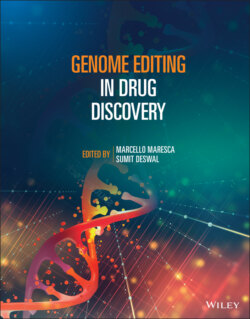Читать книгу Genome Editing in Drug Discovery - Группа авторов - Страница 23
2.3 BAC Recombineering
ОглавлениеThe use of recombineering has been particularly important for functional genomics programmes where BAC transgenes or Gene Targeting constructs have been engineered at large scale to generate animal models of disease or to develop libraries of gene tagging. The European Conditional Mouse Mutagenesis (EUCOMM) and Knock‐Out Mouse Programme (KOMP) contributed to the large‐scale generation of conditional gene KO mice that have been extensively used in Drug Discovery. In particular, Skarnes and colleagues developed a large conditional knock‐out mouse library in the framework of the EUCOMM programme by using a high‐throughput gene‐targeting pipeline based on Recombineering (Skarnes et al. 2011). This gene‐targeting pipeline has been greatly facilitated by the development of a high‐throughput strategy of DNA engineering where “recombineered” targeting constructs were used to engineer C57BL/6N mouse embryonic stem cell for the generation of KO mice. This mouse library has been instrumental to understand the function of genes encoded by the mammalian genomes (In vivo) and to validate drug targets.
Another particular relevant example of Recombineering applications in Drug Discovery/Development is the remarkable work by scientists at Regeneron Pharmaceuticals aimed to engineer a humanized mouse model producing human–mouse hybrid antibodies. Their VelociGene platform (Murphy 1998) allowed the generation of multiple knock‐out/knock‐in by an high‐throughput recombineering & gene targeting approach where “recombineered” BACs are inserted in mESC using sequential homologous recombination steps. This led to the replacement of mouse immune genes with human orthologs (Valenzuela et al. 2003).
Finally, a very relevant application of Recombineering is the generation of tagged genes libraries. Gene tagging can potentially overcome the use of high‐affinity antibodies to detect gene expression, but it is limited by the lack of faithful gene activity of tagged protein generated with the use of overexpressed cDNA vectors. BAC transgenes guarantee a quas‐physiological level of gene expression maintaining transgene regulatory element and promoters, although the tagged gene is not integrated in its endogenous locus but in a so‐called third allele. The generation of tagged BAC libraries at scale was greatly simplified by selecting recombineering events in liquid bacterial culture. The potential of this system is exemplified by the generation of genome‐wide BAC libraries for the analysis of protein localization in Daino Rerio and Caenorhabditis elegans (Sarov et al. 2006).
